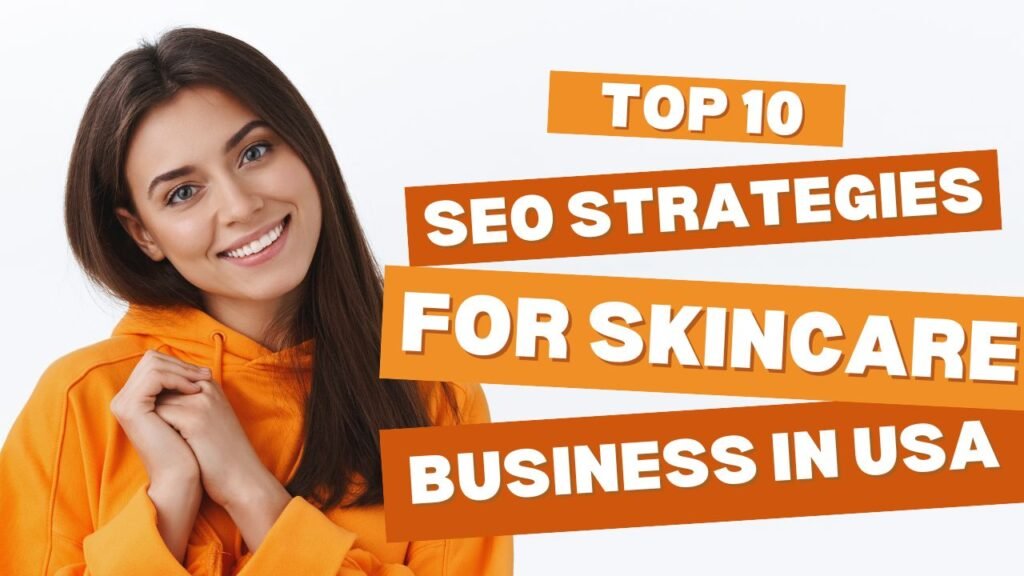
Why Skincare Brands Must Invest in SEO
The skincare and beauty industry in the USA is booming, but it’s also fiercely competitive. With thousands of eCommerce stores, beauty clinics, spas, and influencer-driven brands fighting for attention, standing out online is no easy task. Paid ads can help in the short term, but long-term success requires something more sustainable: Search Engine Optimization (SEO).
SEO ensures that when someone types “best face serum for dry skin” or “skincare clinic near me” into Google, your brand shows up before competitors. Unlike paid ads that stop working when the budget runs out, SEO builds organic visibility and authority that continues to generate traffic, sales, and leads over time.
For skincare businesses, whether you’re selling products, running a spa, or building a beauty brand, SEO is not just about rankings. It’s about attracting the right audience, building trust, and turning searchers into loyal customers.
In this guide, we’ll explore the Top 10 SEO strategies for skincare businesses in the USA, covering everything from keyword research to technical optimization, so you can boost visibility and grow your brand.
SEO Challenges in the Skincare Industry
Before diving into specific skincare SEO strategies, it’s important to understand the unique challenges beauty and skincare brands face when trying to rank on Google:
1. High Competition
The skincare market is crowded with global giants (like L’Oréal, Neutrogena, and The Ordinary), niche boutique brands, dermatologists, and even beauty influencers. Competing with these players requires smart targeting of long-tail keywords and unique branding.
2. eCommerce Complexity
Most skincare businesses sell products online, often through Shopify, WooCommerce, or custom eCommerce platforms. Without proper eCommerce SEO (optimized product pages, structured data, schema markup), it’s easy to get buried under thousands of competing listings.
3. Influencer Dominance
Beauty influencers dominate social media and YouTube searches. Many customers look for reviews or skincare routines from influencers first, making it harder for brands to rank for certain keywords. SEO strategies must adapt by leveraging content partnerships and backlinking.
4. Constantly Changing Trends
The skincare industry thrives on trends: one year it’s K-beauty, next year it’s retinol serums or clean beauty. This creates keyword volatility, meaning brands need ongoing SEO monitoring to capture new search demand.
5. Trust & Compliance Issues
Consumers want to be sure skincare products are safe and effective. Google also emphasizes E-E-A-T (Experience, Expertise, Authoritativeness, Trustworthiness) for health and beauty content. That means skincare brands must create credible, well-researched content backed by expertise.
Strategy 1: Keyword Research for Skincare Products
Keyword research is the foundation of any successful SEO for skincare businesses USA. Without it, you risk targeting overly broad terms like “face cream”, where competition is dominated by billion-dollar brands, instead of more specific, buyer-intent keywords that can actually drive sales.
How to Do It:
- Use tools like Google Keyword Planner, Ahrefs, or SEMrush to find relevant search terms.
- Focus on long-tail keywords such as:
- “best vitamin C serum for sensitive skin USA”
- “organic anti-aging cream Houston”
- “skincare routine for acne-prone skin”
- Segment keywords into categories: product-specific, informational (blogs), and local (for spas/clinics).
Why It Works:
By targeting long-tail keywords, skincare brands avoid head-to-head battles with global companies and instead capture high-intent buyers who are ready to purchase or book an appointment.
👉 Pro Tip: If you’re a skincare business based in Houston, TX, working with a local SEO partner can make all the difference. In fact, you can explore some of the best agencies specializing in digital growth.
Strategy 2: On-Page SEO (Product Descriptions, Blogs, Category Pages)
On-page SEO is where many skincare brands either succeed or fail. Every page on your website, from product descriptions to category collections and blog posts, needs to be optimized for both search engines and customers.
Best Practices for Skincare On-Page SEO:
- Unique Product Descriptions: Avoid copy-pasting manufacturer text. Write original, benefit-driven descriptions targeting keywords like “hydrating face mask for dry skin USA.”
- Category Page Optimization: Instead of simply listing products, add introductory text that explains the benefits of the category (e.g., “anti-aging serums” or “organic skincare”).
- Blog Integration: Create supporting blog posts that internally link to product pages. Example: a blog on “5 Benefits of Retinol for Skincare” linking to your retinol serum product page.
- Header Tags (H1, H2, H3): Organize content with proper keyword-rich headings.
- Meta Tags & Schema Markup: Optimize meta titles and descriptions for CTR and use structured data for rich snippets.
Why It Works:
On-page SEO builds a clear, keyword-focused structure for your website while also creating a better shopping experience for your customers. This results in higher rankings and increased conversions.
👉 If you want to see how on-page SEO fuels long-term growth in another highly competitive sector, check out our in-depth guide: The Complete Guide to Digital Marketing for Healthcare Businesses in the USA. The principles are similar, it’s all about targeting the right audience and building trust.
Strategy 3: Blogging for Skincare Traffic
A well-maintained blog is one of the most powerful skincare SEO strategies because it allows you to rank for informational and long-tail keywords that customers are actively searching for before making a purchase.
Why Blogging Matters for Skincare SEO:
- Educates Customers: Blogs can answer common skincare questions like “How to build a skincare routine for oily skin” or “Best natural remedies for acne.”
- Supports Product Sales: Each article can strategically link to related skincare products, boosting conversions.
- Improves Authority: High-quality content builds trust, which is critical in the beauty industry where credibility drives purchasing decisions.
- Captures Long-Tail Searches: Blogs target lower-competition keywords that big brands often ignore.
Content Ideas for Skincare Blogs:
- “Top 10 Benefits of Using Hyaluronic Acid in Your Routine”
- “How to Choose the Best Sunscreen for Your Skin Type”
- “Before and After Stories: Real Customers Who Transformed Their Skin”
- Seasonal guides like “Best Skincare Products for Winter Dryness”
Pro Tip:
Create evergreen content (timeless skincare advice) alongside trend-driven pieces (e.g., “Top K-Beauty Trends in 2025”) to balance steady traffic with new opportunities.
Strategy 4: SEO-Optimized Product Images
In the skincare industry, visuals sell. Customers want to see product textures, before-and-after results, and packaging aesthetics. But while images are critical for conversions, they also play a huge role in SEO for beauty brands.
How to Optimize Product Images for SEO:
- Use Descriptive Filenames
- Instead of “IMG123.jpg,” use “vitamin-c-serum-skincare-usa.jpg.”
- Add Alt Text with Keywords
- Alt text helps Google understand the image and improves accessibility. Example: “Organic face moisturizer for sensitive skin USA.”
- Compress for Fast Loading
- Tools like TinyPNG or WebP format reduce file size without sacrificing quality.
- Use Multiple Angles & Lifestyle Shots
- Helps customers visualize real-world use, while giving search engines more context.
- Leverage Image Schema Markup
- Enables rich product snippets in Google Shopping and search results.
Why It Works:
Optimized images boost page speed, user experience, and Google Image Search visibility. Since many shoppers discover skincare products via images, this can be a direct traffic source to your store.
👉 Remember: in competitive markets like skincare, every optimization counts. Your product images aren’t just visuals, they’re SEO assets that can drive organic clicks.
Strategy 5: Skincare Local SEO (for Salons, Spas, Clinics)
Not every skincare business is purely eCommerce. Many brands in the USA also run physical locations, spas, dermatology clinics, medspas, or beauty salons. For these businesses, Local SEO is crucial to drive foot traffic and local appointments.
Key Local SEO Tactics for Skincare Businesses:
- Google Business Profile (GBP) Optimization
- Claim and verify your listing.
- Add correct business info (name, address, phone).
- Upload high-quality images of your clinic or spa.
- Post weekly updates with promotions, skincare tips, or before/after results.
- Local Keyword Targeting
- Use search terms like “skincare clinic in Houston”, “best facial spa near me”, or “chemical peel USA.”
- Add city + service combinations in titles and meta descriptions.
- NAP Consistency
- Ensure your Name, Address, Phone are consistent across Google, Yelp, Facebook, and local directories.
- Encourage Reviews
- Positive reviews build credibility and push you higher in local search results. Always respond to feedback to show engagement.
- Location Pages
- If you have multiple spa/clinic branches, create dedicated local landing pages for each.
Why It Works:
Local SEO ensures that when someone searches “skincare spa near me” on Google Maps, your business appears first. This is critical for salons, spas, and clinics that rely on walk-in and appointment-based clients.
👉 Bonus: If your skincare brand is based in Houston, check out this curated list of agencies that can help boost local visibility: Top 20 Marketing Agencies in Houston TX.
Strategy 6: Building Backlinks (Beauty Blogs, Skincare Influencers)
Backlinks are one of the most powerful ranking signals in SEO. For skincare businesses, building quality backlinks is not just about SEO, it also builds brand authority and trust in a crowded market.
How to Build Backlinks for Skincare Brands:
- Guest Blogging on Beauty Websites
- Write expert skincare tips, ingredient breakdowns, or trend analyses for popular beauty blogs. In return, you’ll often get a link back to your site.
- Influencer Collaborations
- Partner with beauty influencers to review your products. Most influencer websites and blogs will link back to your store when posting reviews.
- Skincare Industry Directories
- Submit your business to reputable skincare and health-related directories for local and niche backlinks.
- PR & Media Coverage
- Pitch your skincare brand to beauty magazines, online publications, and local news outlets. Features in these platforms carry strong authority.
- Content Worth Sharing
- Create before/after case studies, infographics, or unique skincare guides that others naturally want to link to as references.
Why It Works:
The skincare industry thrives on credibility and trust. Backlinks from relevant and high-authority websites signal to Google that your brand is legitimate and valuable, boosting your rankings and helping you outrank competitors.
Strategy 7: eCommerce SEO (Shopify/WooCommerce for Skincare)
Since many skincare businesses in the USA sell products online, eCommerce SEO is essential for visibility and sales. Platforms like Shopify, WooCommerce, and BigCommerce make it easy to set up a store, but ranking well requires optimization beyond the basics.
Key eCommerce SEO Tactics for Skincare Brands:
- Optimized Product Pages
- Use keyword-rich product titles (“Organic Aloe Vera Moisturizer USA”).
- Add unique, benefit-driven descriptions instead of duplicate text.
- Include customer reviews for social proof and SEO value.
- Category Page SEO
- Create rich content on category pages (e.g., “Anti-Aging Serums”) with keyword-focused introductions.
- Add internal links to related products and blogs.
- Faceted Navigation & Filters
- Ensure your filtering system (by skin type, concern, ingredient) doesn’t create duplicate content issues. Use canonical tags when necessary.
- SEO-Friendly URLs
- Keep URLs clean and keyword-rich, e.g., domain.com/skincare/organic-vitamin-c-serum.
- Structured Data (Schema)
- Add product schema for rich snippets (price, availability, reviews).
- Helps products appear in Google Shopping results organically.
- Mobile-First Design
- Most skincare purchases come from mobile devices. A fast, responsive site is critical for both rankings and conversions.
Why It Works:
When done right, skincare eCommerce SEO drives qualified traffic directly to product pages, reducing reliance on ads and helping you scale sales sustainably.
Strategy 8: Technical SEO (Site Speed, Mobile-First)
Even if you have the best skincare products and content, poor technical SEO can hold back your rankings. Skincare customers expect a smooth, fast, and mobile-friendly experience, and so does Google.
Key Technical SEO Factors for Skincare Brands:
- Site Speed Optimization
- Compress images and use next-gen formats like WebP.
- Minimize CSS/JavaScript files.
- Use a Content Delivery Network (CDN) for faster global loading.
- Tools: Google PageSpeed Insights, GTmetrix.
- Mobile-First Design
- Since most skincare shoppers browse on mobile, ensure your site looks great and loads quickly on all devices.
- Test responsiveness using Google’s Mobile-Friendly Test.
- Secure Website (HTTPS)
- SSL certificates are non-negotiable, they’re a trust and ranking factor.
- Crawlability & Indexing
- Use an optimized sitemap and robots.txt to guide search engines.
- Avoid duplicate content issues, especially in eCommerce filters.
- Core Web Vitals (CWV)
- Focus on LCP (Largest Contentful Paint), CLS (Cumulative Layout Shift), and FID (First Input Delay) for a smooth user experience.
- Fix Broken Links & Redirects
- Regularly audit your site to eliminate 404 errors and unnecessary redirects.
Why It Works:
A technically sound site ensures that Google can crawl, index, and rank your skincare store effectively. More importantly, customers enjoy a seamless shopping experience, which directly improves conversions.
Strategy 9: Content Marketing (Before/After Stories, Case Studies)
In the beauty and skincare industry, trust drives conversions. Customers want to see proof that a product actually works before committing to purchase. This is where content marketing comes in, blending SEO with authentic storytelling.
Best Content Marketing Approaches for Skincare SEO:
- Before & After Stories
- Showcase real transformations using your skincare products.
- Optimize these stories with keywords like “before and after acne treatment USA”.
- Customer Case Studies
- Highlight individual success stories (e.g., “How Sarah Cleared Her Skin in 90 Days”).
- These build emotional connections and are highly shareable.
- Ingredient-Focused Content
- Educate customers on trending ingredients like retinol, hyaluronic acid, or niacinamide.
- Example blog: “5 Benefits of Retinol for Anti-Aging Skincare.”
- Video Marketing
- Tutorials like “How to Layer Skincare Products” or “Night Routine for Sensitive Skin.”
- Host on YouTube (great for SEO) and embed on your site.
- Interactive Content
- Quizzes like “What’s Your Skin Type?” or “Which Serum is Right for You?” boost engagement while funneling customers to specific products.
Why It Works:
Content marketing adds depth and authority to your skincare brand. By showing real results and educating customers, you not only rank higher in search engines but also win customer loyalty.
Strategy 10: Tracking SEO Performance (Google Analytics, Search Console)
SEO is not a “set it and forget it” process, especially in a competitive space like skincare. To know what’s working and where to improve, you must track, measure, and refine your SEO efforts.
Essential Tools for Skincare SEO Tracking:
- Google Analytics (GA4)
- Track website traffic, conversions, and user behavior.
- Identify which blog posts or product pages bring the most organic sales.
- Google Search Console (GSC)
- Monitor keyword rankings, impressions, and click-through rates (CTR).
- Spot indexing issues, broken links, or slow-loading pages.
- Rank Tracking Tools
- Use SEMrush, Ahrefs, or Ubersuggest to keep an eye on keyword movements for “SEO for skincare businesses USA” and other targets.
- eCommerce Metrics
- Monitor conversion rates, average order value (AOV), and cart abandonment rates.
- Track which SEO-driven campaigns lead to actual revenue.
- Regular SEO Audits
- Conduct quarterly audits to check for broken backlinks, duplicate content, or slow product pages.
Why It Works:
Tracking SEO performance ensures you’re investing in strategies that deliver ROI. Without analytics, you risk spending time on tactics that don’t move the needle.
Conclusion
The skincare market in the USA is booming, but competition is fierce. By applying these top 10 skincare SEO strategies, from keyword research and local SEO to technical optimization and content marketing, you can build a strong, lasting presence online.
👉 Ready to elevate your skincare brand? AdonisTechs specializes in SEO for beauty brands and skincare businesses in the USA. Whether you need a full eCommerce SEO strategy or local SEO for your spa or clinic, our team delivers results.
📩 Need help growing your skincare brand? Contact AdonisTechs today for custom SEO solutions tailored to your business.



Best marketing agency in Houston, TX, USA